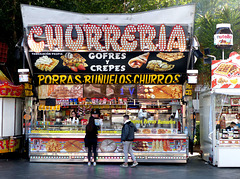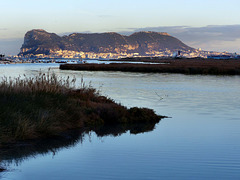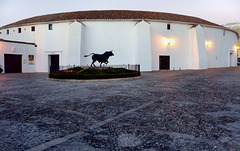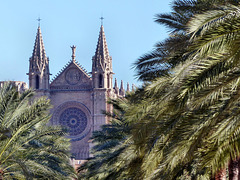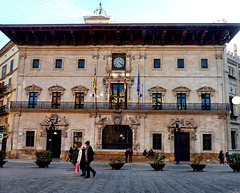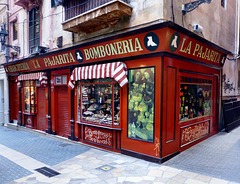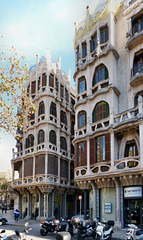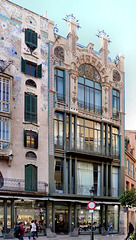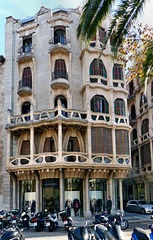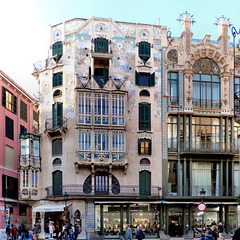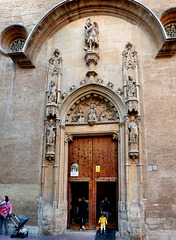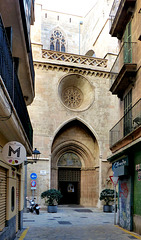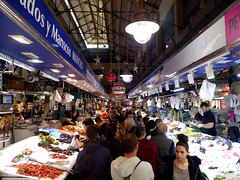
España / Spain
Palma - Churreria
| |
|
Mallorca is the largest island in the Mediterranean Balearic Islands, which are part of Spain. Mallorca is an extremely popular holiday destination. The Palma de Mallorca Airport, one of the busiest in Spain, is used by about 30 million tourists per year.
Palma is the political and economic center of the autonomous region of the Balearic Islands. Palma is a Roman foundation from the time the island was occupied by the Roman Empire in 123 BC. Almost half of the island´s population of more than 890.000 today live in Palma.
From Between 902 and 1229 the city was under Islamic control. It was conquered after three months of siege in December 1229 by the troops of James I of Aragon ( aka "Jaume el Conqueridor"). Palma became the capital of the Kingdom of Majorca. After Jame´s death, Palma became joint capital of the Kingdom, together with Perpignan. The Aragonese expanded the city, so that at its heyday in the 16th century it had around 40,000 inhabitants.
The first time I had churros was when I walked to Santiago de Compostela in 2010. Meanwhile, churros have made it all over Europe. I had them from Palermo up to Hamburg.
Vitoria-Gasteiz - Plaza de la Virgen Blanca
| |
|
|
The Visigoth king Leovigild founded a city called Victoriacum on the occasion of a victory over the Basques in the 6th century. In 1181, King Sancho the Wise of Navarre founded what is now Vitoria, named Nueva Victoria. This was an extension of the already existing Basque settlement of Gasteiz, which was developed into a fortification against Castile. In 1199, the town was besieged for nine months and eventually captured by the troops of Alfonso VIII of Castile, who annexed the town to the Kingdom of Castile. The town was progressively enlarged and in 1431 it was granted a city charter.
The Battle of Vitoria of the Peninsular War occurred near Vitoria-Gasteiz on 21 June 1813. An allied army under General Wellington broke the French army under Joseph Bonaparte. The victory assured the eventual end of French control in Spain. There is a monument commemorating this battle in the main square of the city known as the Monument to Independence.
Tui
| |
|
Standing on the "International Bridge". The Rio Minho is the border between Portugal an Spain. Tui, the "first" town in Spain is clearly dominated by the cathedral on the hill.
Gibraltar
| |
|
|
|
The rock of Gibraltar has a very long history, bit I will cut it very short now
Anglo-Dutch forces captured Gibraltar from Spain in 1704 during the War of the Spanish Succession on behalf of the Habsburg claim to the Spanish throne. The territory was ceded to Great Britain in perpetuity under the Treaty of Utrecht in 1713. The rock controls the entrance and exit to the Mediterranean Sea, as the Strait of Gibraltar is only 13 km.
In a referendum held in 2002, Gibraltarians rejected by a majority (99%) a proposal of shared sovereignty on which Spain and Britain were said to have reached "broad agreement". So this is still British.
Ronda - Plaza de Toros
| |
|
|
Ronda was known to the Romans by the name of Arunda. At the end of the Roman Empire it was taken by the Suebi and later part of the Visigoth realm. In 713 it fell to the Berbers, who built a castle on the Roman foundations. The troops of the Marquis of Cádiz conquered Ronda after a siege in 1485.
The Spanish decreed that all Muslims must either convert to Christianity or leave Spain without their belongings. Muslims who converted were called Moriscos, they had to wear upon their hats a blue crescent. In 1566 Philip II decreed the use of the Arabic language illegal, required that doors open on Fridays to verify that no Muslim Friday prayers were conducted. This led to a rebellion. The Muslim soldiers defeated the Spanish army sent to suppress them. The massacre prompted Phillip II to order the expulsion of all Moriscos in Ronda.
Ronda´s Moorish old town, La Ciudad, is located on a steeply sloping rock plateau. The old town is separated from the younger part, El Mercadillo, by the "Tajo de Ronda" a narrow gorge almost 100 meters deep, formed by the Guadalevín River.
The "Plaza de Toros" in Ronda is the oldest bullfight ring in Spain, Construction of the bullring started in 1779 and finished in 1785. It has a capacity of 6000. Ernest Hemingway, who spent some summers in Ronda, for sure visited this bullring very often, before he wrote "Death in the Afternoon".
Palma - Catedral de Mallorca
| |
|
|
Mallorca is the largest island in the Mediterranean Balearic Islands, which are part of Spain. Mallorca is an extremely popular holiday destination. The Palma de Mallorca Airport, one of the busiest in Spain, is used by about 30 million tourists per year.
Palma is the political and economic center of the autonomous region of the Balearic Islands. Palma is a Roman foundation from the time the island was occupied by the Roman Empire in 123 BC. Almost half of the island´s population of more than 890.000 today live in Palma.
From Between 902 and 1229, the city was under Islamic control and the Palma Cathedral ("Catedral de Santa María de Palma de Mallorca") was erected on the site of a former mosque. Designed in the Catalan Gothic style, it was begun by King James I of Aragon (Jaime I de Aragón) in 1230 but only finished in 1601.
Palma - Ayuntamiento de Palma
| |
|
|
Mallorca is the largest island in the Mediterranean Balearic Islands, which are part of Spain. Mallorca is an extremely popular holiday destination. The Palma de Mallorca Airport, one of the busiest in Spain, is used by about 30 million tourists per year.
Palma is the political and economic center of the autonomous region of the Balearic Islands. Palma is a Roman foundation from the time the island was occupied by the Roman Empire in 123 BC. Almost half of the island´s population of more than 890.000 today live in Palma.
From Between 902 and 1229 the city was under Islamic control. It was conquered after three months of siege in December 1229 by the troops of James I of Aragon ( aka "Jaume el Conqueridor"). Palma became the capital of the Kingdom of Majorca. After Jame´s death, Palma became joint capital of the Kingdom, together with Perpignan. The Aragonese expanded the city, so that at its heyday in the 16th century it had around 40,000 inhabitants.
The "Ajuntament de Palma (Palma City Council) is popularly known as "Cort". The Baroque building, located in the Plaza de Cort, was built between 1649 and 1680.
Palma - La Pajarita
| |
|
|
Mallorca is the largest island in the Mediterranean Balearic Islands, which are part of Spain. Mallorca is an extremely popular holiday destination. The Palma de Mallorca Airport, one of the busiest in Spain, is used by about 30 million tourists per year.
Palma is the political and economic center of the autonomous region of the Balearic Islands. Palma is a Roman foundation from the time the island was occupied by the Roman Empire in 123 BC. Almost half of the island´s population of more than 890.000 today live in Palma.
From Between 902 and 1229 the city was under Islamic control. It was conquered after three months of siege in December 1229 by the troops of James I of Aragon ( aka "Jaume el Conqueridor"). Palma became the capital of the Kingdom of Majorca. After Jame´s death, Palma became joint capital of the Kingdom, together with Perpignan. The Aragonese expanded the city, so that at its heyday in the 16th century it had around 40,000 inhabitants.
La Pajarita, founded in 1872, is undisputed the very best Bomboniera in Palma. In case you have a sweet tooth, try the candied fruits. The Charcuteria to the left offers local delicacies.
Palma - Can Casasayas & Pensión Menorquina
| |
|
|
Mallorca is the largest island in the Mediterranean Balearic Islands, which are part of Spain. Mallorca is an extremely popular holiday destination. The Palma de Mallorca Airport, one of the busiest in Spain, is used by about 30 million tourists per year.
Palma is the political and economic center of the autonomous region of the Balearic Islands. Palma is a Roman foundation from the time the island was occupied by the Roman Empire in 123 BC. Almost half of the island´s population of more than 890.000 today live in Palma.
From Between 902 and 1229 the city was under Islamic control. It was conquered after three months of siege in December 1229 by the troops of James I of Aragon ( aka "Jaume el Conqueridor"). Palma became the capital of the Kingdom of Majorca. After Jame´s death, Palma became joint capital of the Kingdom, together with Perpignan. The Aragonese expanded the city, so that at its heyday in the 16th century it had around 40,000 inhabitants.
Around the turn of the century, Palma was a wealthy city and so the citizens could afford to contract famous Catalan architects, known for the Modernisme Català, a specific form of the Art Nouveau. Lluís Domènech i Montaner and Josep Puig i Cadafalch have worked in Palma and there are numerous beautiful buildings in the inner city. The Can Casasayas & Pensión Menorquina are located at Plaça del Mercat 13-14. The ensemble was built 1908 - 1911 designed by Francesc Roca i Simó.
Palma - Almacenes El Águila
| |
|
|
Mallorca is the largest island in the Mediterranean Balearic Islands, which are part of Spain. Mallorca is an extremely popular holiday destination. The Palma de Mallorca Airport, one of the busiest in Spain, is used by about 30 million tourists per year.
Palma is the political and economic center of the autonomous region of the Balearic Islands. Palma is a Roman foundation from the time the island was occupied by the Roman Empire in 123 BC. Almost half of the island´s population of more than 890.000 today live in Palma.
From Between 902 and 1229 the city was under Islamic control. It was conquered after three months of siege in December 1229 by the troops of James I of Aragon ( aka "Jaume el Conqueridor"). Palma became the capital of the Kingdom of Majorca. After Jame´s death, Palma became joint capital of the Kingdom, together with Perpignan. The Aragonese expanded the city, so that at its heyday in the 16th century it had around 40,000 inhabitants.
Around the turn of the century, Palma was a wealthy city and so the citizens could afford to contract famous Catalan architects, known for the Modernisme Català, a specific form of the Art Nouveau. Lluís Domènech i Montaner and Josep Puig i Cadafalch have worked in Palma and there are numerous beautiful buildings in the inner city.
The former El Águila department store was designed by Gaspar Bennássar and Jaume Alenyar in 1908. Since it was a commercial building, appropriate solutions had to be found to make the most of the space and interior lighting. Iron was used as a decorative element. The result was a facade with large windows and doors that attract attention and allow plenty of daylight to flow into the building.
Palma - Can Casasayas & Pensión Menorquina
| |
|
|
Mallorca is the largest island in the Mediterranean Balearic Islands, which are part of Spain. Mallorca is an extremely popular holiday destination. The Palma de Mallorca Airport, one of the busiest in Spain, is used by about 30 million tourists per year.
Palma is the political and economic center of the autonomous region of the Balearic Islands. Palma is a Roman foundation from the time the island was occupied by the Roman Empire in 123 BC. Almost half of the island´s population of more than 890.000 today live in Palma.
From Between 902 and 1229 the city was under Islamic control. It was conquered after three months of siege in December 1229 by the troops of James I of Aragon ( aka "Jaume el Conqueridor"). Palma became the capital of the Kingdom of Majorca. After Jame´s death, Palma became joint capital of the Kingdom, together with Perpignan. The Aragonese expanded the city, so that at its heyday in the 16th century it had around 40,000 inhabitants.
Around the turn of the century, Palma was a wealthy city and so the citizens could afford to contract famous Catalan architects, known for the Modernisme Català, a specific form of the Art Nouveau. Lluís Domènech i Montaner and Josep Puig i Cadafalch have worked in Palma and there are numerous beautiful buildings in the inner city. The Can Casasayas & Pensión Menorquina are located at Plaça del Mercat 13-14. The ensemble was built 1908 - 1911 designed by Francesc Roca i Simó.
Palma - Almacenes El Águila
| |
|
|
|
Mallorca is the largest island in the Mediterranean Balearic Islands, which are part of Spain. Mallorca is an extremely popular holiday destination. The Palma de Mallorca Airport, one of the busiest in Spain, is used by about 30 million tourists per year.
Palma is the political and economic center of the autonomous region of the Balearic Islands. Palma is a Roman foundation from the time the island was occupied by the Roman Empire in 123 BC. Almost half of the island´s population of more than 890.000 today live in Palma.
From Between 902 and 1229 the city was under Islamic control. It was conquered after three months of siege in December 1229 by the troops of James I of Aragon ( aka "Jaume el Conqueridor"). Palma became the capital of the Kingdom of Majorca. After Jame´s death, Palma became joint capital of the Kingdom, together with Perpignan. The Aragonese expanded the city, so that at its heyday in the 16th century it had around 40,000 inhabitants.
Around the turn of the century, Palma was a wealthy city and so the citizens could afford to contract famous Catalan architects, known for the Modernisme Català, a specific form of the Art Nouveau. Lluís Domènech i Montaner and Josep Puig i Cadafalch have worked in Palma and there are numerous beautiful buildings in the inner city.
The former El Águila department store was designed by Gaspar Bennássar and Jaume Alenyar in 1908. Since it was a commercial building, appropriate solutions had to be found to make the most of the space and interior lighting. Iron was used as a decorative element. The result was a facade with large windows and doors that attract attention and allow plenty of daylight to flow into the building.
Palma - Basílica de San Miguel
| |
|
Mallorca is the largest island in the Mediterranean Balearic Islands, which are part of Spain. Mallorca is an extremely popular holiday destination. The Palma de Mallorca Airport, one of the busiest in Spain, is used by about 30 million tourists per year.
Palma is the political and economic center of the autonomous region of the Balearic Islands. Palma is a Roman foundation from the time the island was occupied by the Roman Empire in 123 BC. Almost half of the island´s population of more than 890.000 today live in Palma.
From Between 902 and 1229 the city was under Islamic control. It was conquered after three months of siege in December 1229 by the troops of James I of Aragon ( aka "Jaume el Conqueridor"). Palma became the capital of the Kingdom of Majorca. After Jame´s death, Palma became joint capital of the Kingdom, together with Perpignan. The Aragonese expanded the city, so that at its heyday in the 16th century it had around 40,000 inhabitants.
San Miquel was built after the Reconquista from 1229 on the site of the great mosque of Madina Mayurqa. In 1390 a larger new building was built in the Gothic style.
The single-nave church has a Gothic portal begun in 1398 by the Pere de Sant Joan. The tympanum has the Virgin with the Child and two angels. The most interesting statue is on the left. The sculpture depicts Ramon Llull.
Ramon Llull (1232 – 1315) was a mathematician, polymath, philosopher, logician, writer from the Kingdom of Mallorca. He is credited with writing the first major work of Catalan literature and considered a pioneer of computation theory, especially given his influence on Gottfried Wilhelm Leibniz.
Since his first writings, there has been confusion regarding whether he was a saint or a heretic. Spanish King Philipp II. was fond of his work and used parts of it in the creation of the Monasterio del Escorial. Prior to that, Llull was considered a heretic by most. Llull's works were prohibited by the Spanish Inquisition.
Llull urged the study of Arabic and other languages in Europe. He travelled through Europe to meet with popes, kings, and princes, trying to establish colleges to prepare future missionaries. In 1276 a language school for Franciscan missionaries was founded at Miramar.
About 1291 he went to Tunis, preached to the Saracens, disputed with them in philosophy. He returned in 1308. He finally achieved his goal of linguistic education in 1311 when the Council of Vienne ordered the creation of chairs of Hebrew, Arabic and Aramaic at the universities of Bologna, Oxford, Paris, and Salamanca.
In 1314, at the age of 82, he travelled again to North Africa where he was stoned by an angry crowd of Muslims in Tunis. Merchants took him back to Mallorca, where he died in Palma the following year.
Within the Franciscan Order Llull is honoured as a martyr. He was beatified in 1847 by Pope Pius IX.
Palma - Santa Eulàlia
| |
|
Mallorca is the largest island in the Mediterranean Balearic Islands, which are part of Spain. Mallorca is an extremely popular holiday destination. The Palma de Mallorca Airport, one of the busiest in Spain, is used by about 30 million tourists per year.
Palma is the political and economic center of the autonomous region of the Balearic Islands. Palma is a Roman foundation from the time the island was occupied by the Roman Empire in 123 BC. Almost half of the island´s population of more than 890.000 today live in Palma.
From Between 902 and 1229 the city was under Islamic control. It was conquered after three months of siege in December 1229 by the troops of James I of Aragon ( aka "Jaume el Conqueridor"). Palma became the capital of the Kingdom of Majorca. After Jame´s death, Palma became joint capital of the Kingdom, together with Perpignan. The Aragonese expanded the city, so that at its heyday in the 16th century it had around 40,000 inhabitants.
The erection of Santa Eulàlia, (maybe) the oldest church in Palma, started just weeks after the conquest of Mallorca by King James I the Conqueror in December 1299. Like most churches of the early times, it was built on the ruins of an Arab mosque.
The three-aisled, cross-shaped church was dedicated to Saint Eulàlia, who was venerated as the patron saint of Barcelona at the time.
The Jewish quarter belonged to the administrative district of the parish of Santa Eulàlia. In 1391 there was a peasant revolt which was directed against the Jews. The pogrom on the night of August 2, 1391, resulted in over 300 deaths. Many Jews were able to flee to northern Africa. Others converted to Christianity in this parish to save their lives. This side portal, seen here, is known as the silversmiths´ portal because that was the profession practised by most of the converted Jews.
Palma - Santa Eulàlia
| |
|
Mallorca is the largest island in the Mediterranean Balearic Islands, which are part of Spain. Mallorca is an extremely popular holiday destination. The Palma de Mallorca Airport, one of the busiest in Spain, is used by about 30 million tourists per year.
Palma is the political and economic center of the autonomous region of the Balearic Islands. Palma is a Roman foundation from the time the island was occupied by the Roman Empire in 123 BC. Almost half of the island´s population of more than 890.000 today live in Palma.
From Between 902 and 1229 the city was under Islamic control. It was conquered after three months of siege in December 1229 by the troops of James I of Aragon ( aka "Jaume el Conqueridor"). Palma became the capital of the Kingdom of Majorca. After Jame´s death, Palma became joint capital of the Kingdom, together with Perpignan. The Aragonese expanded the city, so that at its heyday in the 16th century it had around 40,000 inhabitants.
The erection of Santa Eulàlia, (maybe) the oldest church in Palma, started just weeks after the conquest of Mallorca by King James I the Conqueror in December 1299. Like most churches of the early times, it was built on the ruins of an Arab mosque.
The three-aisled, cross-shaped church was dedicated to Saint Eulàlia, who was venerated as the patron saint of Barcelona at the time.
After an earthquake in the 19th century, the main facade was rebuilt and finished in Neo-gothic style. Only the amazing rose window was preserved from the original facade from the 1400s.
Palma - Santa Eulàlia
| |
|
Mallorca is the largest island in the Mediterranean Balearic Islands, which are part of Spain. Mallorca is an extremely popular holiday destination. The Palma de Mallorca Airport, one of the busiest in Spain, is used by about 30 million tourists per year.
Palma is the political and economic center of the autonomous region of the Balearic Islands. Palma is a Roman foundation from the time the island was occupied by the Roman Empire in 123 BC. Almost half of the island´s population of more than 890.000 today live in Palma.
From Between 902 and 1229 the city was under Islamic control. It was conquered after three months of siege in December 1229 by the troops of James I of Aragon ( aka "Jaume el Conqueridor"). Palma became the capital of the Kingdom of Majorca. After Jame´s death, Palma became joint capital of the Kingdom, together with Perpignan. The Aragonese expanded the city, so that at its heyday in the 16th century it had around 40,000 inhabitants.
The erection of Santa Eulàlia, (maybe) the oldest church in Palma, started just weeks after the conquest of Mallorca by King James I the Conqueror in December 1299. Like most churches of the early times, it was built on the ruins of an Arab mosque.
The three-aisled, cross-shaped church was dedicated to Saint Eulàlia, who was venerated as the patron saint of Barcelona at the time.
It was here that in 1276 James II, son of King James I (Jaume el Conqueridor) took oath when being crowned King of Mallorca.
Palma - Mercat de l'Olivar
| |
|
Mallorca is the largest island in the Mediterranean Balearic Islands, which are part of Spain. Mallorca is an extremely popular holiday destination. The Palma de Mallorca Airport, one of the busiest in Spain, is used by about 30 million tourists per year.
Palma is the political and economic center of the autonomous region of the Balearic Islands. Palma is a Roman foundation from the time the island was occupied by the Roman Empire in 123 BC. Almost half of the island´s population of more than 890.000 today live in Palma.
From Between 902 and 1229 the city was under Islamic control. It was conquered after three months of siege in December 1229 by the troops of James I of Aragon ( aka "Jaume el Conqueridor"). Palma became the capital of the Kingdom of Majorca. After Jame´s death, Palma became joint capital of the Kingdom, together with Perpignan. The Aragonese expanded the city, so that at its heyday in the 16th century it had around 40,000 inhabitants.
Mercat de l'Olivar is the large covered food market of Palma. Just before Christmas, it is very busy here. More than one hundred of delicatessen stalls sell all sorts of food - fruit, vegetables, ham, sausages, cheese, bread, oil, olives, fish ... Between the stalls are a couple of tiny restaurants and takeaways.
Palma - Catedral de Mallorca
| |
|
|
Mallorca is the largest island in the Mediterranean Balearic Islands, which are part of Spain. Mallorca is an extremely popular holiday destination. The Palma de Mallorca Airport, one of the busiest in Spain, is used by about 30 million tourists per year.
Palma is the political and economic center of the autonomous region of the Balearic Islands. Palma is a Roman foundation from the time the island was occupied by the Roman Empire in 123 BC. Almost half of the island´s population of more than 890.000 today live in Palma.
From Between 902 and 1229 the city was under Islamic control. It was conquered after three months of siege in December 1229 by the troops of James I of Aragon ( aka "Jaume el Conqueridor"). Palma became the capital of the Kingdom of Majorca. After Jame´s death, Palma became joint capital of the Kingdom, together with Perpignan. The Aragonese expanded the city, so that at its heyday in the 16th century it had around 40,000 inhabitants.
The foundation stone for the cathedral was laid in 1230 by King James I of Aragon (Jaume el Conqueridor) after the conquest of Mallorca in 1229. It was erected in the Catalan Gothic style on the site of a former mosque. Under Jaume II, the son of the conqueror, the actual construction of the cathedral began in 1306 from the main apse. The nave was completed in 1587, the main portal was consecrated in 1601. Work on the main facade began in 1852 and was not finished until the beginning of the 20th century.
The cathedral is 109.50 m long and 33 meters wide, the main nave measures 75.50 m length and 19.50 m width. The main nave is 44 m high, which is higher than the nave of Notre Dame de Paris (33m) and Notre-Dame d'Amiens (42m), but lower than the nave of Saint-Pierre de Beauvais, with a height of 48m the highest of all Gothic cathedrals.
The central portal.
Jump to top
RSS feed- Latest items - Subscribe to the latest items added to this album
- ipernity © 2007-2024
- Help & Contact
|
Club news
|
About ipernity
|
History |
ipernity Club & Prices |
Guide of good conduct
Donate | Group guidelines | Privacy policy | Terms of use | Statutes | In memoria -
Facebook
Twitter

